What is it with ham radio that grabs some us for a lifetime while the rest of the population fails to grasp what we do? Talk to a ham and he will tell you about his wife, careers, houses, locations and cars. They all come and go during our lifetime but this ham radio hobby of ours is sometimes the most constant thing in our lives. Some would claim that we require professional help. Others say it is a wonderful thing to be able to throw a switch and have a place a place to go to. That place is for us is all around the world with our DXing friends.
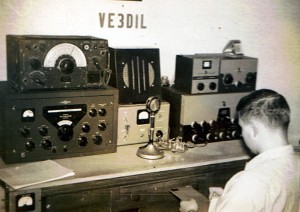
VE3DIL in 1957. Collins 75A2 with Surplus R1155 Rx on top, Johnson Viking 2, VFO and Matchbox. I still have the Astatic D-104 to this day!
Most Amateur Radio Operators have similar stories of how we got started in ham radio. They are wonderful stories of how our imaginations were captured, first stations with meager equipment and learning the skills from our fellow hams who often become lifelong friends. We hams are often anti-social away from our hobby but very social within the hobby. I often wonder about that and am sure a psychologist could do a thesis on it.
It’s been a long haul for those of us who have been lucky enough to witness the demise of valve technology and witness the rise of solid state devices.
Beginnings to Now, 62 years later
I was born in Toronto and grew up there. A quest for a Signalman’s Badge in the Boy Scouts taught me semaphore and the disciplines of morse code. My first receiver was a one valve affair from Popular Mechanics magazine using a Type 49 as a superegenerative receiver. Little did I know that I was living in a part of the city of Toronto that had six 1KW AM ham stations within one mile of me. After learning that one of them lived only a block away, I turned up on his doorstep one Saturday evening to actually see a ham station operating. Fred, VE3TC became my mentor and encouraged me to get my code speed up to 10 Wpm and do some study for the Canadian exam. I went to Northern Technical School and during my 2nd year of high school, I met a classmate who learned I was interested in Ham Radio. He said that his father was a ham and would I like to meet him? His Father, Val Sharpe VE3LJ had a six foot rack kilowatt transmitter beside his desk and an Eddystone 750 receiver. He had a homebrew 3el 10M yagi in the backyard if I remember correctly. It was 1951 and I was 14. Val was talking to the other side of the world on 10 Meters and was I impressed! Val helped me a lot on how to work DX and the correct use of operating procedures
I was bitten by the Ham Radio bug and have never recovered.
Morse code training in high school ( C.C.T.S. Commonwealth Cadet Training Scheme ) was a piece of cake because I was a young lad and I didn’t know how difficult it was. My High School Science teacher, George Kingston, VE3ARE spent many late afternoons and lunch hours with three of us at the school teaching us enough to pass the Canadian exam. During the year of study using VE3ARE, I managed to work all Canadian provinces and all 48 US States. By the time I sat my licence the code speed was up to nearly 2O WPM. and just before I turned 16 in 1953, gained my general class licence and was issued VE3DIL.
All this on 40M CW using a Canadian 19 set with Russian markings and a 40M dipole on the 3rd floor roof of the high school! (19 Set below)
One year later I sat the code again at 15 WPM and the advanced theory to gain my Advanced class ticket. Two meters was a part of life in Canada for me. It was all local AM phone or CW if you wanted to work the USA to the south. This meant big power and even bigger antennas. When the Aurora Borealis was on, you pointed your antenna North and bounced signals off the Aurora to head south into the USA. The clear CW note went into the Aurora and it was unbelievably modulated with a raspy, raw AC buzz which precluded other AM modes. One local in Toronto worked 46 States using this method. Exciting stuff for us in the middle 1950’s! During 1960, the original holder of VE3DIL, Bill McFadden contacted me and wanted his old call back. I applied for and was issued one of the new C suffix callsigns VE3CDX and used that for a few years before I applied for a two letter call.
The 1960 saw the growth of Repeaters in Toronto. VE3RPT quickly captured the hundreds of stations that previously operated mobile each morning on the way to work I had no trouble giving up the 100W of AM, separate receiver and 8 Foot centre loaded whip for a converted Motorola FM radio operating into VE3RPT. In 1990, my wife and I, along with our two boys went to back to Toronto. VE3RPT is now residing on top of the CN Tower which is 1840 Feet high and is the tallest man made structure in the world. With an antenna that high the coverage is quite extraordinary.
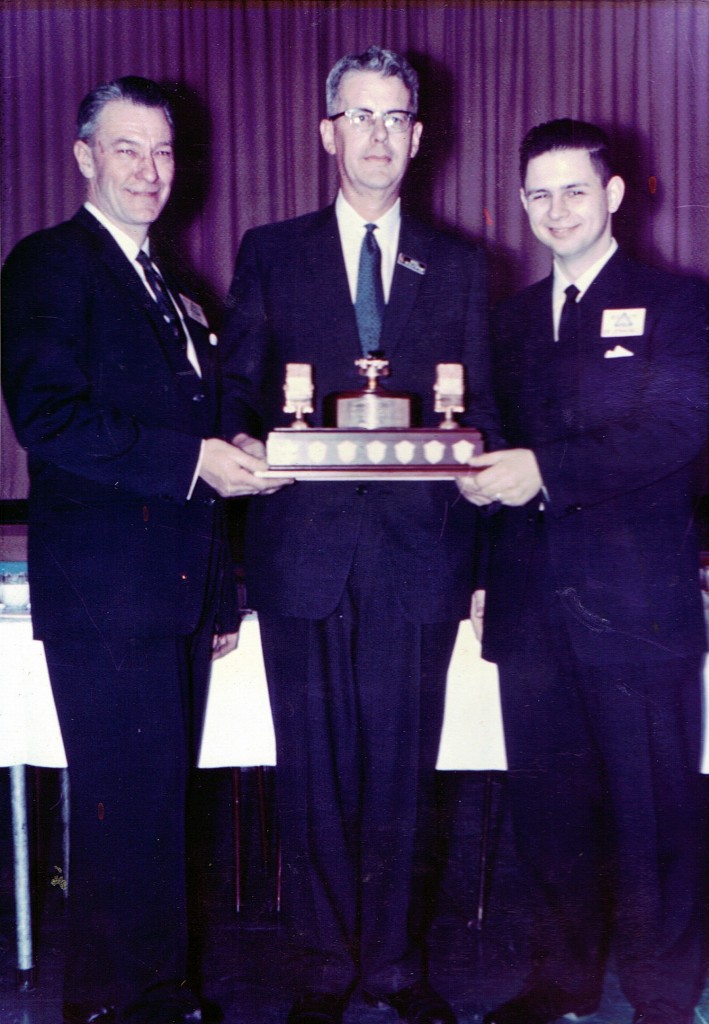
Bill Cate VE3HR – Noel Eaton VE3CJ – Lee Jennings VE3OE Noel is presenting the Keith Russell Field Day Trophy to the Scarborough Amateur Radio Club for winning the Ontario Division
Field Day has always held interest for me. The organized chaos of Canadian multi multi Field Day stations are unbelievable. About 70 hams descend on a farmer’s paddock and proceed to set up Phone and CW stations on all bands starting at 6AM in the morning. By noon the site has spread out over 10 acres with tents, generators radio gear and big antennas. In 1962 I had the pleasure of being the Scarborough Amateur Radio Club’s field day coordinator. VE3WE won the ARRL Canadian division Multi multi contest beating our arch rival the Nortown Amateur Radio Club across town.
My Advanced Class licence in 1953 turned me loose on the DX bands. 20 metres quickly became “my band” It still is today. By the early 1960’s I was well and truly hooked on DXing. My station at that time consisted of Collins KWS-1 (1 kw) and 75A4 receiver for 80 and 40 with a Collins S Line and a 30L1 KW linear into a TH6DXX Yagi. It was state of the art in tube technology and was very effective in getting me near the 300 countries I wanted. Several super high power linears consumed my time during that period. A purpose built 20 metre linear using a 4-1000 operating at 4500 volts with peaks of just over an ampere was particularly successful. The 872 mercury vapour rectifiers would pulse in time with the SSB peaks and when the lights were out in the shack, the eerie glow was happiness for me, but a sure sign of madness to the many visitors to my shack.
Life is to short for QRP. I have always run high power stations, probably because I like living “close to the edge.” When something goes wrong with any component in high power circuitry, the result is spectacular in the extreme and it makes you feel a little humble and a little proud when the smoke finally clears and you are still alive! Canadian hams have a theory about antennas. If it stays up during the winter, it is too small. The many ice storms in southern Ontario have wiped out thousands of amateur antennas over the years. The problem is one of ice buildup. As the rain freezes on the elements, they increase in size rapidly to the point of a one inch diameter aluminium tube turning into a two inch diameter icicle. There is nothing so sad as a four element 20 metre yagi folded up along the boom with the elements pointing to earth. Cubical quads succumb early on in an ice storm. TV antenna installers drive Cadillac and Rolls Royce cars.
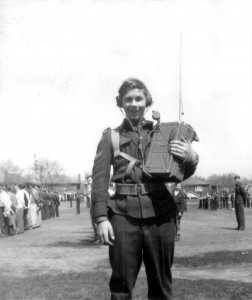
On my High School parade ground with the battery operated
Army 58 Set and 6′ whip antenna. Portable but very heavy!
Canada at that time was a member of the CCTS (Commonwealth Cadet Training Scheme) and every high school student had to have military training. Fortunately there was a regiment of the RCEME (Royal Canadian Electrical and Mechanical Engineers) in Toronto and they provided training to the school. And of, course I was in for that in a big way as I could use the portable 58 Sets to walk around the parade grounds talking to my mates and looking like we were doing something. I managed to get out of marching and parade ground duty for all time!
I worked mostly CW and the furthest part of the planet was down under in ZL/VK land. It always sounded a bit exotic to me and I was bitten by the DX bug. When you become a rabid Dxer you have no money as it always goes on improving antennas and radio gear. It doesn’t help being a teenager either as there are lots of other ways to spend money.
War surplus radio equipment was plentiful around Toronto in the early 50s. Bendix TA12s, BC348Qs, R1155s sold for under $25.00 and ARC5 Command sets were $5.00 for any model in the pile.
By 1955 SSB and RTTY surfaced. It was the era of converting whatever possible to end up on SSB. Controversy and hard feelings raged on the air across North America. Some old timers gave up the hobby because they couldn’t cope with product detectors, demodulators and lack of suitable carriers to hang one’s sidebands on. It was a magic time for me building ever larger antennas and experimenting with RTTY and SSB. At that time, one either built a resistor phasing unit or ground down war surplus 455 kHz crystals to generate a SSB signal. The ultimate was a Central Electronics 20A exciter, amplifier and a Collins 75A2 or National NC300 receiver.
I have fond memories of reading about a linear amplifier in QST magazine that used a pair of 6AG7 valves and gave one the astounding output of nearly 40 watts PEP with 600V on them. Since war surplus 6AG7’s with metal surrounds were selling at 25 cents each, I thought that perhaps if I ran eight of them in parallel the output would double. It did but they got quite hot. Then I had the brilliant idea of turning them upside down and submersing the metal envelopes in a pan of water. I found that then I could run up the voltage to nearly 1000V before the valves got hot and the water started to boil. The obvious solution was to run some cold running water through a tube into the pan and out the other side continuously. This worked very well for a while until either terminal flashover occurred or the heat inside melted the cathodes. The spectacular result was usually the same; 8 or 10 more 6AG7s from the surplus store. On the other hand, the 6AG7’s were cheap. My parents despaired of me every time the lights went out in our house!
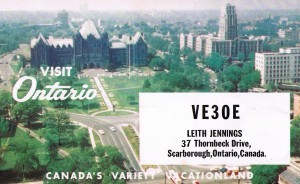 During the 50s and 60s I was an engineer for IBM Canada and also worked for Motorola before I trained as a technical teacher in the late 1960s. I was VE3OE during that time and I found it a brilliant callsign to use. Amateur radio mobile in the 50s was all AM, dynamotors and big 75 metre “bug catcher” 8’ whip antennas. Slowly that scene waned as the 2 metre repeaters became more popular around Toronto. Changing technology is the constant theme of our hobby.
During the 50s and 60s I was an engineer for IBM Canada and also worked for Motorola before I trained as a technical teacher in the late 1960s. I was VE3OE during that time and I found it a brilliant callsign to use. Amateur radio mobile in the 50s was all AM, dynamotors and big 75 metre “bug catcher” 8’ whip antennas. Slowly that scene waned as the 2 metre repeaters became more popular around Toronto. Changing technology is the constant theme of our hobby.
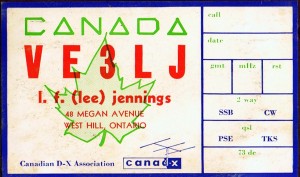 During the early 1960’s I was eligible for a coveted “two letter call’ and was duly issued VE3OE by the Radio Inspector Ray Nason VE3RN. At that time the Deptartment of Transport controlled all the radio services and was up on the second floor of the offices above the Union Station in Downtown Toronto. I used VE3OE effectively until 1967.
During the early 1960’s I was eligible for a coveted “two letter call’ and was duly issued VE3OE by the Radio Inspector Ray Nason VE3RN. At that time the Deptartment of Transport controlled all the radio services and was up on the second floor of the offices above the Union Station in Downtown Toronto. I used VE3OE effectively until 1967.
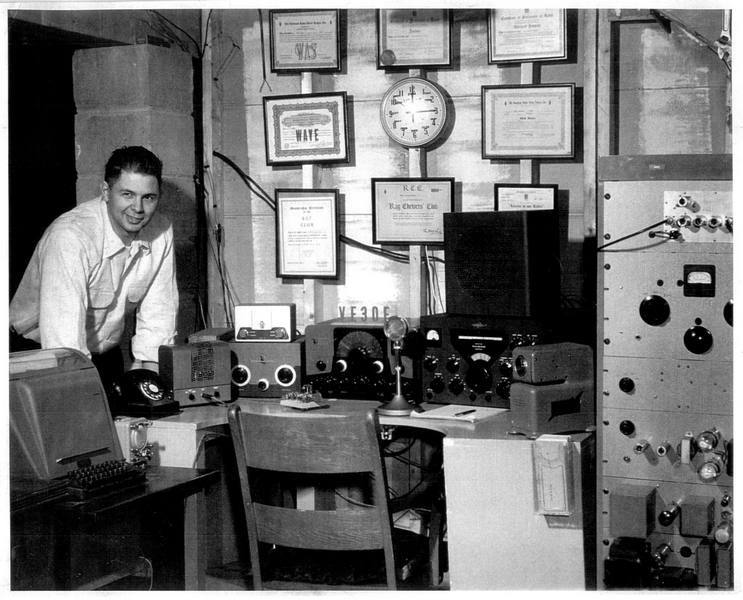
VE3OE in 1961 – Johnson Ranger, Pair 813s Amplifier, Collins 75A4, Matchbox, Model 26 Teletype and TH3 Antenna
When my early mentor Val Sharpe VE3LJ passed away his wife wanted me to have VE3LJ as they were my initials and I became VE3LJ until I left Canada in 1969 for New Zealand.VE3LJ was a good callsign but not nearly as easy to use as VE3OE. During that time as VE3OE and later VE3LJ my interest in RTTY became all consuming and the lure of surplus Teletype machines became all consuming. The top stations of the day used Model 19s and Model 28s if you were lucky enough to find one. I just loved working on these old mechanical marvels working out how they were designed. I joined several large transcontinental RTTY traffic nets and even got involved with SELCAL radio which was the art of leaving personal messages on someone else’s unattended machinery. It was state of the art stuff using Irv Hoff’s designed, homebrew RTTY demodulator. All tubes of course and 88 Mhy toroid filters with super narrow selectivity. By this time the whole standard of RTTY has changed from 850 Hz shift to 170 Hz shift. Microprocessors and indeed small home computers were not available but some discussions in ham mag editorials looked like they would arrive on the scene in another ten years.
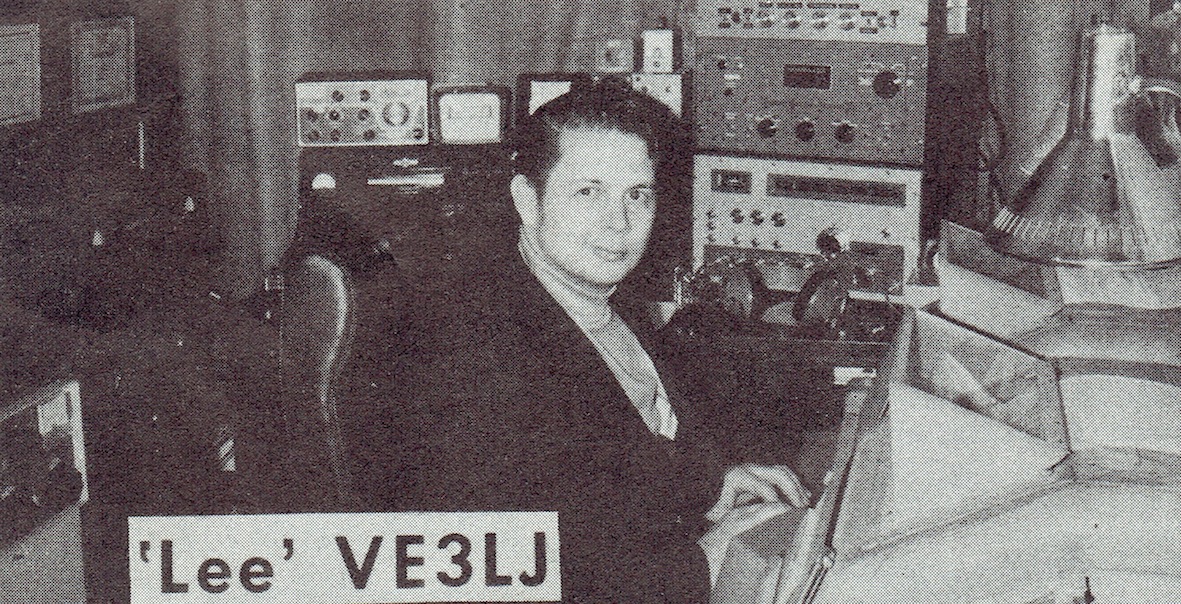
I was heavily into RTTY in the late 1960s. The stations consisted of the Collins “Gold Dust Twins” 75A4 and KWS-1. I also have the Drake R4B and TX4B driving a BTI1000 Amplifier. FSK originated in a Homebrew ST-6 Terminal Unit. I had 2 x Teletype Model 15s and a tape reader. it was all state of the art then. RTTY now bears no resemblance to those golden days!
VE3LJ looked like this in 1967. Two model 19s, a model 28 and the Collins 75A-4 and KWS-1 “Gold Dust Twins” combination. I used a Drake T4XC driving a BTI 2000 amplifier. You can see it directly behind me. The picture is a photocopy of an article which appeared in the RTTY Journal in 1968 out of California.
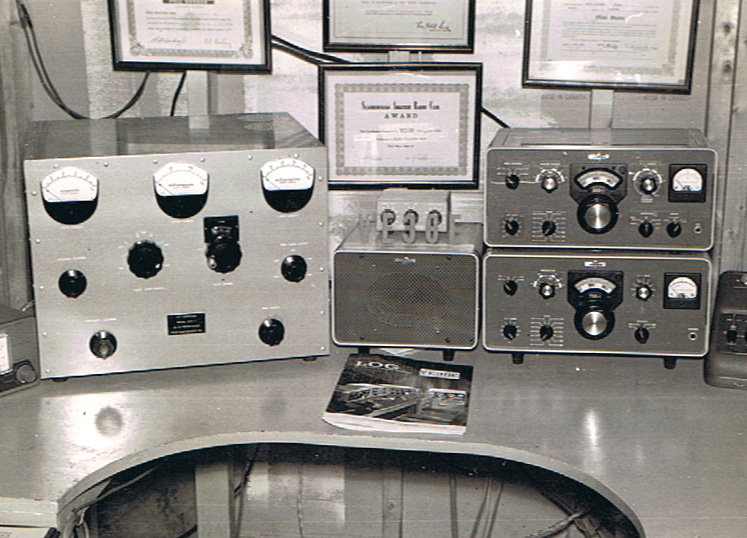
Amplifier Pair 4-400s KW and Collins S-Line. The antenna was a TH6DXX up 80 feet. The station was really successful
The kilowatt amplifier above was one that I built in 1964. It ran a pair of 4-400s in GG and paired with the Collins S-Line, worked very well for my trying to get to the top of the DXCC lists. That era in DXing was racked with scandal as Don Miller W9WNV ran DXpeditions from places that were unique. He was very popular on the air but the fact was that he often wasn’t operating from where he said he was. As a consequence, the ARRL DXCC board disallowed some of his operations. He decided to sue the ARRL and it all ended badly with Don leaving the DX scene.
After moving to ZL in 1970 I did very little DXing until 1992 when the bug bit again and DX chasing was back on the menu. The story continues with the growth of ZL2AL operating from the Bay of Plenty, Palmerston North, New Plymouth, Hastings for 30 years and finally Napier for the past 7 years.
Now, as ZL2AL and 64 years of nearly continuous ham radio, 26 logbooks and around 100,000 contacts logged plus all the unlogged ones, the hobby still fascinates me, During the last 20 years I have had the pleasure of operating with a great bunch of guys on the ZL7AA, ZL8RI, ZL9CI and ZL7T DXpeditions. Returning home each time made me realize what a great hobby this is. During 2006 I got a team of local operators together and we became the East Coast Contesters as ZM4T A group of guys playing radio for a contest weekend or a few weeks of DXpedition madness is priceless fun. The finish of each event sees us all wanting to do it again! DXpeditioners and Contesters are really the lunatic fringe of our hobby. The team has been going for 8 years and has achieved some remarkable international records and achievements. As I write this in October 2013 we are about to do battle again with a huge Multi-Multi effort and try to break our own records at ZM4T. Some would say that the the world is mad and hams are quite normal, healthy reasonable people to associate with. Some would say our geeky endeavours are quite mad. Ham radio is the king of hobbies and I am proud to have met so many friends over those 62 years.
“The worst day of ham radio DXing or Contesting is
Infinitely better than the best day working!”
73 de Lee ZL2AL

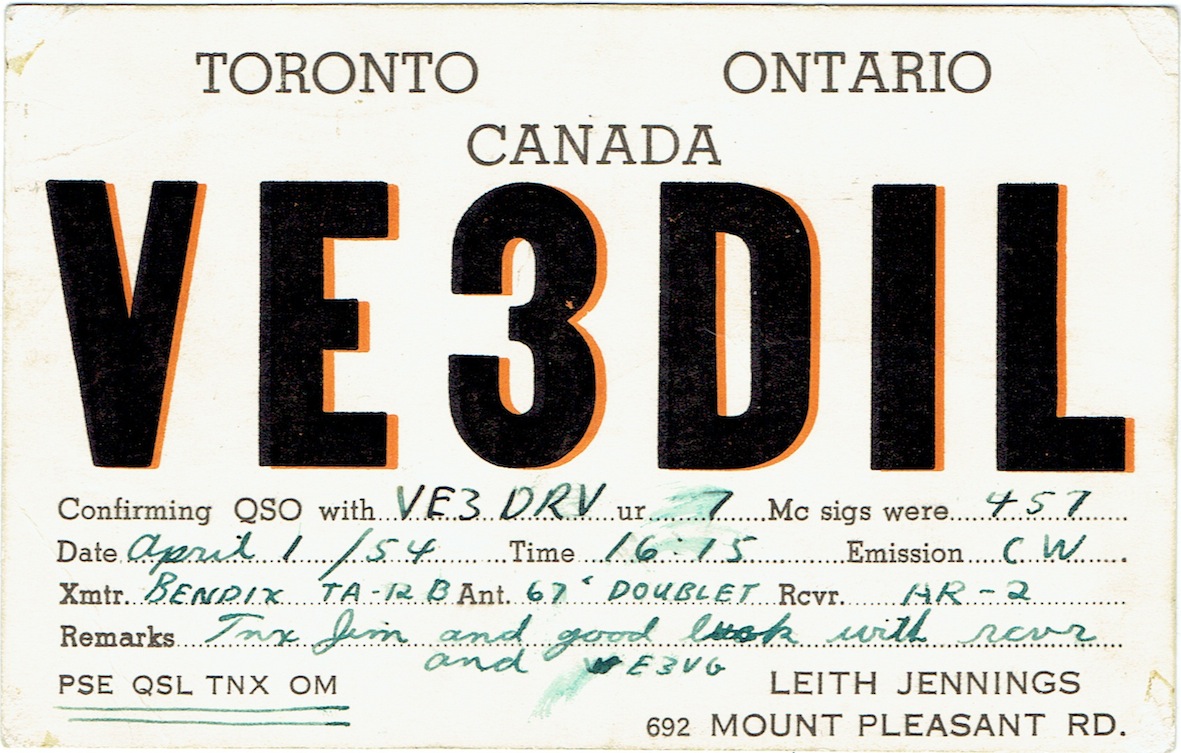
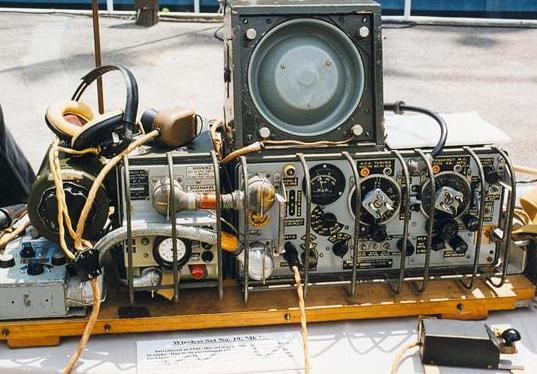
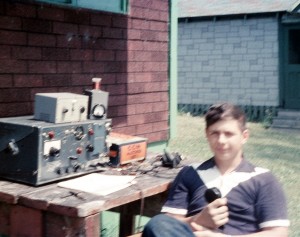
Hi Lee Nice to hear from you again.Yes we attend all of the ham fests in the area.This way we get to try out a lot of different equipment.Glad to hear your still active and it is a great hobby.The Markham flea market takes place tomorrow.It is always well attended. One more this year at the Kingston military museum located on the base.It was nice to see the VE3LJ card and read your article. You have seen a lot of changes in your lifetime in the hobby .All the best 7/3 Bill VE3LJ / VE3KZL
You remember your old friend Bill Cate ve3hr? He recently passed away at 101.